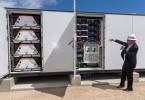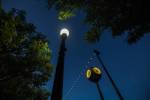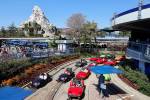Let the sun shine in. Solar energy is wave of the future
Oil has exceeded $108 a barrel and the cost of other fossil fuels is skyrocketing as well. It's becoming a challenge for many just to keep their homes comfortable and afford the price of gas to get to and from work. We've designed our society around the car and an assumption of endless abundance of cheap energy. The problem is that the energy we've been focused on is the old stuff, ancient in fact, buried in the ground and full of carbon. It's time for the post-carbon revolution.
One could say that this is all about nuclear energy, but not the kind that leads to toxic waste or dangerous explosives. There is only one source of nuclear energy that really works well. It has a proven track record and is extremely reliable. In addition, it has a built-in wireless global delivery system. There is no waste, fuel costs are immune from inflation and the power is not concentrated in any particular country or region. And it is located exactly where a nuclear power plant should be: 93 million miles away.
We have an endless abundance of cheap energy. The solution rises every day.
Just to give you some perspective, let's do a comparison. First, consider the ancient stuff: all known reserves of oil, coal, natural gas, tar sands and even uranium-235. Collectively, they represent just under 11 million terawatt hours of energy potential (and dwindling every day). A terawatt hour is 1 billion kilowatt hours -- a whole bunch of power.
Now, how much direct solar energy is available each year? About 350 million terawatt hours. In other words, the amount of clean, renewable energy from the sun in one year dwarfs the total amount of all fossil fuels that exist on and in the Earth for all time.
Relatively speaking there's not much of the buried, ancient stuff left, but it's more than enough to get us into big trouble if we continue to dig it up and burn it. Sunlight is fresh energy, only eight minutes old. Personally, I like the fresh stuff better, like most folks.
The real question is just how do we make this transition to a post-carbon society that is driven by fresh, clean energy? We need to learn everything we can and do our part, whatever that may be. For some, it's writing to their senators or congressmen asking them to support renewable-energy legislation. For others it's adopting renewables on whatever scale they can afford. The key, as always, is education.
If we can shift policy and gain enough support for this transition, all of us could soon be living in solar-powered homes, with or without actual panels on the roof. And how will that help you fill your car up with gas? As more fresh solar energy becomes available, so too will plug-in hybrid vehicles that can get us around without all the oil.
The American Solar Energy Society is an excellent source of information about the benefits of renewable energy. Solar 2008, its yearly technical conference, occurs in San Diego on May 3-8. Solar 2008 (www.solar2008.org) is the premier event for solar energy and energy-efficiency professionals in the United States.
This is where our policy-makers and utility representatives should be heading. Architects and green builders, investors, entrepreneurs all play important roles to hasten the transition to a post-carbon economy. Perhaps you are thinking of changing careers or you're a student with an eye on what the future holds. Solar 2008 is the event for you.
The solar-energy industry is growing at an unprecedented rate. After all, it is inevitable. Yet, we must take every opportunity to learn from the experts and from each other in order to manage this transition and maximize its potential.
One of the planned plenary sessions is entitled Community Solutions and will feature Edward Mazria, architect and founder of Architecture 2030; Daniel Lerch, post-carbon cities program manager at the Post Carbon Institute; and Timothy N. Tutt of the California Energy Commission. What could be better than attending an event that focuses on solutions and learning how we can implement them in our own community?
Nevada, along with the rest of the planet, is on the verge of a major energy transformation that will have profound and long-term effects on each of us. Energy-efficiency programs for home and business will help us better manage our energy use. Our first solar home community is under way in Henderson. Renewable-energy programs and projects will change our state from a dirty energy importer to a clean energy exporter. These processes, and others like them, will play a major role in the creation of a vibrant, healthy post-carbon society, but we must act now.
If you are in a position to do so, please consider attending Solar 2008. It's not far to travel, the weather is great and the opportunities are better than ever before. I hope to see you there! Together, perhaps we can turn Nevada into "The Solar State."
And a quick reminder: Don't miss the Southern Nevada Solar Home Tour on April 5. Register now at www.solarnv.org.
Steve Rypka is a green living consultant and president of GreenDream Enterprises, specializing in renewable energy, green building, alternative transportation and lifestyle choices for both residential and commercial clients. The company is committed to helping people live lighter on the planet. Rypka can be reached via e-mail at steve@greendream.biz. More information relating to this column is posted at www.greendream.biz.























